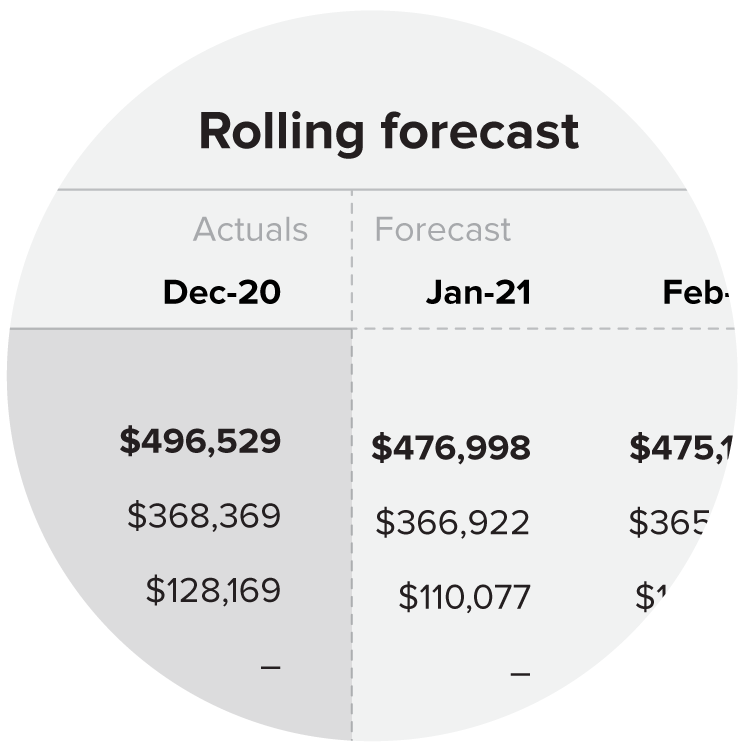Running a small business is a delicate balance between process and flexibility. The fluid nature of pivoting to figure out what works often leads to a solid process. When done correctly, this balance of agility and stability creates growth.
Forecasts are often considered a tool in the “process” toolbag. A once-a-year report that gives an estimate for cash flow, sales, and other key drivers of your business. Sounds like something for companies that are more steady or bigger — but that’s not accurate.
There is another type of financial model that allows virtually any business to benefit from predicting where their company will be in the future. It’s called a “rolling forecast.”
You need a fluid financial model
Traditional, annual forecasts use previous financial data to predict how the upcoming year may look. They’re created and used to gauge progress. Sadly, they are often underutilized. You may take a look to see how close (or far off) you are to the targets, but it’s not a tool that really helps achieve your objectives.
Example one (traditional forecast): A company creates a forecast for the coming year in December. By May, a staffing problem emerges due to regular growth. Leadership must now begin the hiring process, check to see how it will affect cash flow and scramble to keep things moving.
Example two: Another organization uses a rolling forecast, updated based on a number of factors, including marketing efforts. After a social ad strategy works well (early on in Q1), the model is updated and Q2 guidance changes significantly. Leadership accurately sees down the pike and updates priorities, spending, and hiring to meet the incoming demand.
Key question: Do you find yourself saying “we need to XYZ” or “we will need to XYZ?”
A rolling forecast is a continuous model that is regularly updated and automated. When done correctly, it’s more of a living document that improves over time. And when used correctly, this type of forecast allows you to:
- Recognize early-on if your predicted figures are off (either positive or negative)
- Clearly see what’s causing the increase/decrease (by tracking the key drivers of success)
- Quickly pivot based on potential scenarios (that can be done on the fly)
Bottom line: A rolling forecast actually helps improve flexibility and process. Plus, the longer you use it, the more accurate and useful the forecast becomes.
5 best practices to building your own rolling forecast
Rolling forecast best practice #1: Set the goals and targets
The first step toward a useful rolling forecast is attaching it to your goals. It’s not simply about predicting what’s likely to happen, based on previous performance. A great forecast includes attainable objectives.
A few of the most common include:
- Sales revenue
- Profit margin
- Improving cash flow
Some metrics may not be financial, but they impact (or are impacted by) the overall performance of your company.
A small sampling of these objectives are:
- Adding new product/revenue stream(s)
- User/client growth (primarily for SaaS companies, especially when seeking an investment round)
- Increased revenue per transaction, lifetime value, etc.
Rolling forecast best practice #2: Pick the time frame
There are two elements to the rolling forecast time frame. First, is how long you’ll move into the future (typically 12 months, but sometimes 18 or even 24 months). Then, set how often it will rollover.
Example: A 12-month forecast, beginning in January and rolling over month-to-month.
On February 1st, the January forecast drops off at the beginning of the report. Next January is added to the end, as well. So, there are still 12 months in the forecast.
Here are three common examples of the rollover periods:
Week-to-week: Early-stage startups and quick-moving businesses may need frequent updates to the model. If revenues/margins change in a moment’s notice, there’s a lot of pivoting and a forecast is a great way to navigate tumultuous waters.
Month-to-month: Most companies likely fall into this camp. Monthly updates keep the numbers fresh and help your executive team stay on top of their piece of the puzzle, meeting goals and expectations.
Quarter-to-quarter: A more established business may not need more than a quarterly rollover. It’s also a bigger picture for board meetings and others who aren’t in the day-to-day operations of the business.
Rolling forecast best practice #3: Remember accuracy vs. precision
Achieving accuracy is better than being precise. Precision aims to get it perfect, the first time around. Accuracy intends to give useful intel in the near term while becoming even more accurate over time. And a rolling forecast fits in perfectly with this mindset.
Your forecast isn’t a crystal ball offering 100% spot-on revenue each month. It’s a tool to better run your business, while not bogging you down. A best practice for your rolling model is to ensure it’s:
Easy to manipulate and understand: The finance team needs to be able to quickly input new data and tweak the numbers to run different scenarios. Everyone who uses the forecast needs the ability to access and quickly understand what they’re looking at.
Gives a relatively accurate portrayal, without slowing things down: A huge spreadsheet won’t load and will be impossible to update. Your team will not use it. Drop what you don’t need, average numbers where you can in order to create a lightweight and usable product.
Further reading: The accuracy vs. precision mindset is important. You can check out an entire blog post about it right here.
Rolling forecast best practice #4: Build out the key drivers
Again, small businesses require flexibility and process. A traditional forecast is good for a quick glance. If it was close to being accurate, it may help make the decision at hand. A rolling forecast that includes key drivers is more than a prediction — a scenario-planning tool.
The drivers are the key metrics that attribute (or will likely attribute) to the business’ success (and the accuracy of the forecast). These drivers are closely aligned with your objectives.
Some examples include:
- To grow revenue, marketing and sales data are likely critical drivers to success
- Improve profitability, cash flow, and cash-on-hand (e.g. for an acquisition) you’ll likely want to improve average purchase or reduce churn
- To spend investment capital wisely, you’ll want to track payroll numbers and headcount
Drivers well-aligned to your goals create the environment for scenario planning. You can play with how different events will change your forecast. Successful marketing/sales campaigns, a stall in hiring and/or a potential big purchase (affecting cash flow). All of these things are quickly manipulated, showing how it would affect your business. It also clears up the decisions that would need to be made.
Rolling forecast best practice #5: Automatically measure actual and estimated forecasts
As you’ve read this resource, the need for a software solution becomes clear. Opening up an Excel spreadsheet every few weeks to take off the current month and tack it on the end — updating all of the financial predictions — is a bit too much.
Using Jirav, you’re able to build a rolling forecast that allows you to automate much of the data collection and quickly update each metric; making your predictions as accurate as possible. General ledger data, payroll, even custom spreadsheets easily fit right into your custom rolling forecast. And in many cases, the data is pulled in automatically (via integrations). Each month you’ll see how accurate your model was and quickly make needed changes.
A rolling forecast isn’t just an estimate of the coming year’s sales. It’s a living document and a useful tool for growth and planning.
Consider Jirav: your all-in-one FP&A solution
Our philosophy is that financial dashboarding is far more impactful when it is performed holistically as part of a connected financial planning and analysis process. That’s why our solution combines forecasting, budgeting, reporting, and dashboarding in an FP&A solution that integrates all your important data.
See Jirav in action by requesting a free demo and experience for yourself how Jirav makes business planning smarter, faster, and together.













